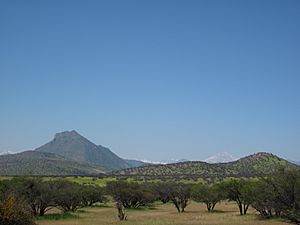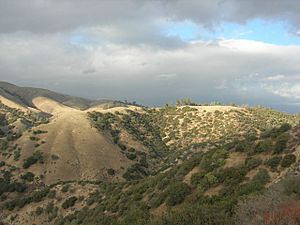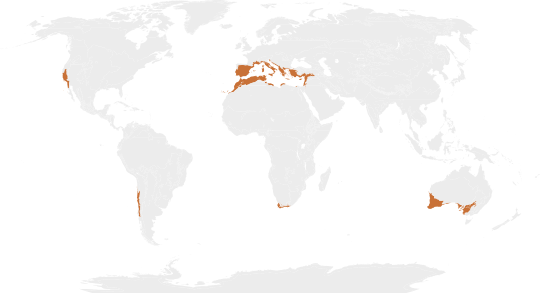Mediterranean forests, woodlands, and scrub facts for kids
Mediterranean forests, woodlands, and scrub is a special type of natural area, called a biome. The World Wide Fund for Nature describes this biome. It usually has dry, hot summers and wet, mild winters. Sometimes, the rain can be spread out more evenly through the year. These areas are very special because they are home to 10% of all the plant species on Earth!
Contents
Where These Biomes Are Found
You can find Mediterranean forests, woodlands, and scrub mostly in places with a Mediterranean climate. These are usually in the middle parts of the Earth, not too close to the poles or the equator.
The main places they are found include:
- The Mediterranean Basin (around the Mediterranean Sea)
- The Chilean Matorral in Chile
- The California chaparral and woodlands in California and Baja California
- The Western Cape in South Africa
- The southwest and southern parts of Australia
Sometimes, these biomes can also be found in other climate zones. This includes drier parts of oceanic and humid subtropical climates. They can also be in wetter parts of semi-arid climate zones. For example, you might see Mediterranean plants along the Nile River Valley in Egypt. They also grow in parts of the Eastern Cape in South Africa and southeastern Australia.
Plants of the Mediterranean Biome

The plants in these areas can be very different. You might see tall forests, open woodlands, savannas, dense shrublands, or wide grasslands. Often, you'll find a mix of these plant types all close together. This creates a "mosaic habitat." The mix depends on the soil, hills, wind, sun, and past fires.
Many woody plants here are "sclerophyll." This Greek word means 'hard-leaved'. Sclerophyll plants usually have small, dark leaves. These leaves have a waxy outer layer. This helps them hold onto water during the dry summer months.
One very special area is the fynbos in South Africa. It has an amazing number of different plant species. About 68% of its 8,600 plant species are found nowhere else in the world! This makes it one of the most diverse plant regions on Earth.
Main Plant Groups

Here are the main types of plant communities you'll find in this biome:
- Forests: Mediterranean forests often have broadleaf trees like oak trees. Examples include the oak forests in California and around the Mediterranean Sea. Southwest Australia has Eucalyptus forests. Central Chile has Nothofagus forests. Forests often grow near rivers, where they get more water in summer. You can also find conifer forests, especially around the Mediterranean.
- Woodlands: Oak woodlands are common in the Mediterranean Basin and California. Pine woodlands are also found in the Mediterranean Basin. California also has walnut woodlands.
- Savannas and Grasslands: The California Central Valley grasslands are the largest Mediterranean grassland. However, most of these grasslands are now farms. The remaining areas have oak, walnut, and pine trees. In Portugal, the cork oak savanna, called montado, is a great example of a Mediterranean savanna.
- Shrublands: These are thick areas of evergreen shrubs and small trees. They are most common near the coast. These plants are often good at handling wind and salty air from the ocean. They have different names in different places:
* Chaparral in California and southern Portugal * Matorral in Chile and southern Spain * Garrigue or maquis in France * Macchia or gariga in Italy * Phrygana in Greece * Tomillares in Spain * Fynbos, renosterveld, Succulent Karoo, and strandveld in South Africa * Kwongan in Southwest Australia * Batha in Israel
Sometimes, shrublands are the natural plant type for an area. Other times, they grow after forests or woodlands have been cut down or overgrazed. They can also grow after big fires.
How Fire Shapes These Areas

Fire, both natural and caused by people, has played a big role in shaping these Mediterranean areas. The hot, dry summers make these regions likely to have fires. Lightning often causes fires naturally. Many plants here are "pyrophytes," which means they love fire. They have adapted to fire or even need it to reproduce. Fire helps them recycle nutrients and clear out old plants.
In Australia and California, native people used fire a lot. They would burn brush and trees. This made space for grasses and other plants that fed animals and were useful to them.
The plants in these areas got used to these frequent fires. Fire-loving plants became more common. Plants that didn't do well with fire became less common. When Europeans came, they tried to stop fires. This caused problems. Fuel (dead plants) built up. So, when fires did happen, they were much bigger and more damaging. Some plants that needed fire to reproduce are now in danger.
If fires happen too often (less than every ten years), some chaparral plants can disappear. This is because they don't have enough time to grow and make seeds before the next fire. If fires keep happening very often, even plants that can regrow from their roots might run out of energy. Today, many accidental fires can turn native shrublands into non-native grasslands. This greatly reduces the number of different plant species, especially when there is also a drought.
Threats to These Biomes
Mediterranean regions are some of the most threatened places on Earth. Many have been greatly damaged. This is due to trees being cut down, too much grazing by animals, and land being turned into farms or cities. Stopping fires has also caused problems. New plants and animals that are not from these areas have also been brought in.
The areas around the Mediterranean Sea and in California have been hit especially hard. They have lost many forests and a lot of soil. Many native plants and animals have disappeared or are now in danger.
See also
 In Spanish: Bosque y matorral mediterráneo para niños
In Spanish: Bosque y matorral mediterráneo para niños
- Aegean and Western Turkey sclerophyllous and mixed forests
- Forest Sciences Centre of Catalonia (CTFC)
- Food and Agriculture Organization (Silva mediterranea workgroup)
Images for kids






